![]()
![]()
![]()
Use LEFT and RIGHT arrow keys to navigate between flashcards;
Use UP and DOWN arrow keys to flip the card;
H to show hint;
A reads text to speech;
74 Cards in this Set
- Front
- Back
|
What are the components of the upper airway?
|
- Sinuses
- Nasopharynx - Oropharynx - Proximal trachea (connected to upper airway via eustacian tube:) - Middle ear - Mastoids / Temporal bone |
|
|
What are the most commonly imaged structures of the upper airway?
|
- Sinuses (most common)
- Temporal bone |
|
|
Why would you image the sinuses?
|
- Chronic sinusitis and complications
- Acute sinusitis - Post-operative - Tumors - Trauma |
|
|
Why would you image the temporal bone?
|
To look at middle ear and mastoids/temporal bone:
- Hearing loss - Trauma - Infection |
|
|
What imaging modalities do you use to image the sinuses?
|
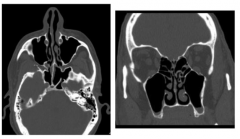
- CT (L=axials w/ reformatted images, R=direct coronals)
- Radiographs (less commonly used) |
|
|
Case: 22 yo male presents to clinic w/ mild cough for 3 days. Vital signs are normal and patient is afebrile. What, if any, imaging tests should be ordered?
|
None - not every patient needs imaging
|
|
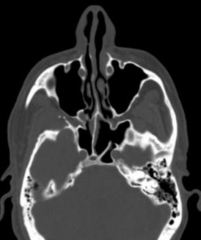
What sinuses can be viewed in this axial section?
|
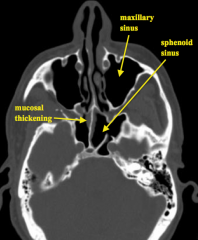
- Maxillary sinuses (at top of image)
- Sphenoid sinuses (posterior / below maxillary sinuses in image) |
|
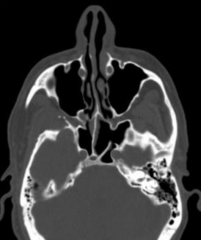
What is the gray structure that is found within the Sphenoid Sinuses?
|
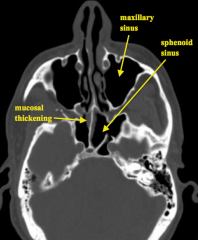
Mucosal thickening (common in fall)
|
|
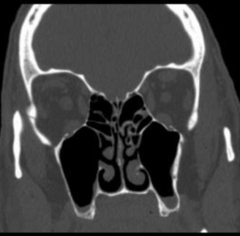
What sinuses can be viewed in this coronal section?
|
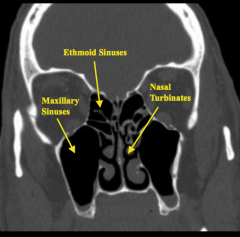
- Ethmoid Sinuses (in between orbits)
- Maxillary Sinuses (below orbits) |
|
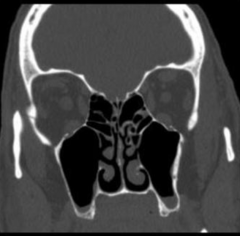
What can be seen at the bottom of the maxillary sinuses?
|
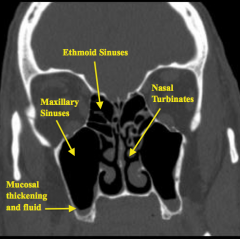
Mucosal thickening and fluid which suggests acute sinusitis (not diagnostic, but in correct clinical setting, it can suggest acute sinusitis)
|
|

What sinuses can be viewed in this axial section?
|
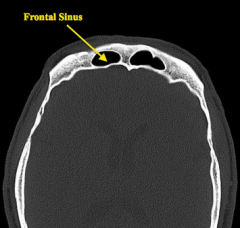
Frontal Sinuses
|
|
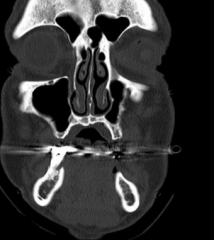
What sinuses can be viewed in this coronal section?
|
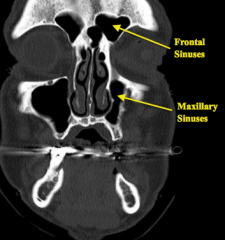
- Frontal Sinuses
- Maxillary Sinuses |
|
|
What is interesting about the frontal sinuses?
|

Not everyone has frontal sinuses, some have only one, and some have enlarged frontal sinuses
|
|
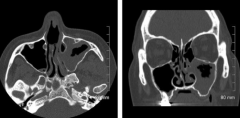
What can be seen in this CT?
|

Acute Sinusitis (probably did not require imaging and could have been treated based on clinical grounds)
- Really thick mucosal thickening on L maxillary sinus - Small mucosal thickening in R maxillary sinus with an air bubble trapped in the secretions |
|
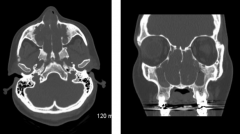
What can be seen in this CT?
|
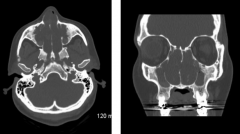
Nasal Polyposis
- Tumor involving nasal cavity, normally they are air filled - Here they are filled with soft tissues, patient can't breath through their nose |
|
|
Why would you get a CT of the temporal bones?
|
- Not to diagnose an ear infection
- Only if you are worried about their being a complication (fever doesn't go away, pain out of proportion, or worried about involvement of cranial structures) |
|
|
What is a potential complication of untreated otitis media?
|
Mastoiditis (infxn of mastoid air cells)
|
|
|
What is a potential complication of untreated otitis externa?
|
Osteomyelitis
|
|
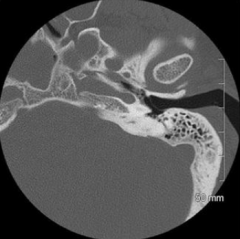
What can be seen in this image?
|
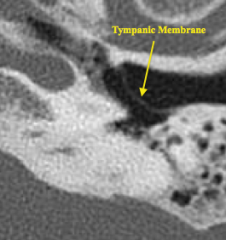
Tympanic membrane
|
|
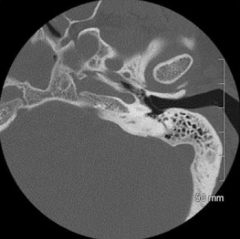
What can be seen in this image?
|
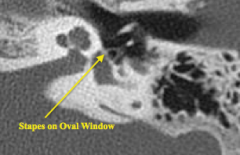
Stapes on Oval Window
|
|
|
Under what circumstances is imaging of the trachea not indicated?
|
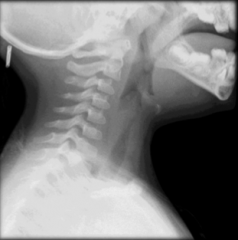
Unusual to image for infections;
- Trachiitis - Bronchitis |
|
|
Under what circumstances is imaging of the trachea indicated?
|
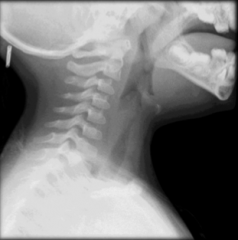
- Epiglottitis
- Tracheal papillmoatosis - Croup |
|
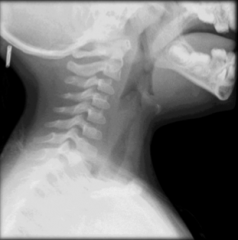
What can be seen in this image?
|
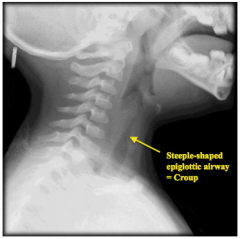
Croup = Steeple Sign on lateral X-ray
- Kids have "barking cough" |
|
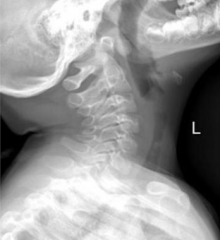
What can be seen in this image?
|
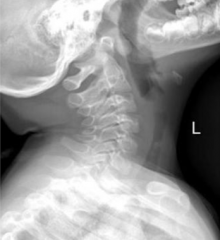
Bacterial Trachiitis
- Trachea is narrowed - Lots of tissue thickening - Material in trachea indicates sloughed membranes d/t infection - Needs to be aggressively treated d/t risk of compromised airways |
|
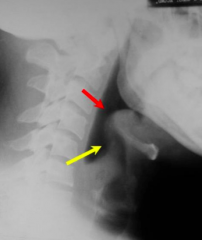
What can be seen in this image?
|
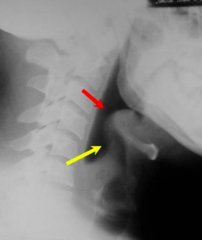
Epiglottitis:
- Inflammation of the epiglottis - Looks like thumb print instead of a thin structure - Not seen very commonly anymore d/t Haemophilus vaccine - Emergency situation and may require tracheotomy to breathe |
|

What can you see on coronal view of the trachea?
|

A = clavicle
B = thyroid gland Tracheal rings L & R bronchi |
|
|
What can happen if the thyroid gland enlarges?
|
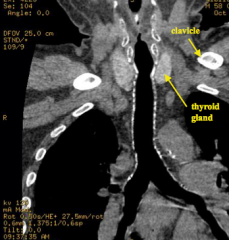
Can impinge on the trachea
|
|
|
When do you commonly do imaging of the trachea?
|
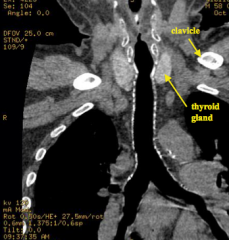
After endotracheal tube
|
|
|
Which bronchus is the endotracheal tube more likely to extend into? Why?
|
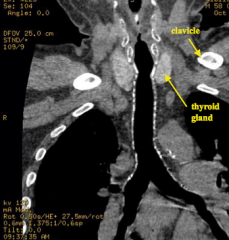
- R bronchus because it extends almost straight down
- L bronchus makes more of an angle - 10:1 ratio of R to L |
|
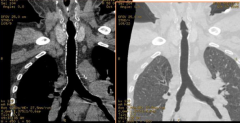
What's the difference between these two images?
|
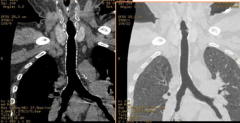
Same image but L focuses on soft tissue and R focuses on lung tissue
|
|
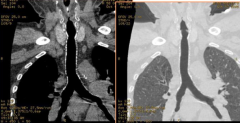
What can you see in the lungs of the R image?
|

Black spots = cystic areas = COPD
|
|

L image shows inspiration and R image shows expiration, what is happening?
|
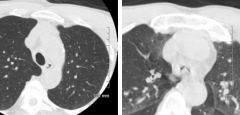
- L image: trachea is wide open
- R image: trachea is closed because it can't maintain its rigid shape (tracheomalacia); leads to wheezing and inability to clear secretions, may lead to pneumonia |
|
|
What happens in Tracheomalacia?
|
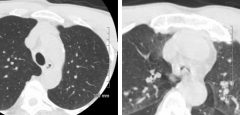
Flaccidity of the tracheal support cartilage which leads to tracheal collapse especially when increased airflow is demanded
(R image - trachea closes during expiration) |
|
|
What is virtual bronchoscopy? What is it used for?
|
Imaging tool that lets you "fly through bronchi" on computer to find nodules or other pathology on trachea so that surgeon can know where to remove the abnormal structures
|
|
|
What do you need to consider when reading a chest x-ray?
|
1. View (what view is this, what view do I need?)
2. Technical aspect / considerations (what is the quality of this image? how does patient's weight affect viewing?) 3. Pattern (use patterned search so you don't miss anything) 4. Projectional anatomy (looking at 2D image of 3D structures) 5. Important signs to identify and further characterize lesion |
|
|
What are the types of views that can be done for a chest x-ray?
|
- PA (posterior to anterior), lateral
- AP (anterior to posterior), upright - AP, supine - Decubitus - Oblique views - Lordotic |
|
|
What is the most common, best quality view for a chest x-ray?
|
PA, lateral (posterior to anterior)
|
|
|
What view for a chest x-ray should you do if the clavicle is in the way?
|
Lordotic - have patient lean shoulders back
|
|
|
What is the pattern to use for evaluating a chest x-ray?
|
1. Mediastinum (look for abnormal contours)
2. Hilum (look at pulmonary a/v, lymphadenopathy) 3. Lung parenchyma (look at each lung individually in L to R, up to down pattern; then look at both lungs simultaneously same way to compare) 4. If there is a nodule determine if it is in rib or lung, and if lung what lobe - may need to use another view to triangulate) 5. Look for pleural effusion 6. Look at bones |
|
|
What normal structures can sometimes appear as a nodule in lung?
|
- Nipple shadow
- Old healed fractured rib |
|
|
What lobes are on the right side? What is their relationship to one another?
|
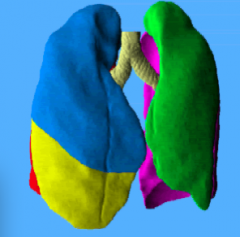
- Right Upper Lobe, Right Middle Lobe, and Right Lower Lobe
- RML and RLL overlap |
|
|
What lobes are on the left side? What is their relationship to one another?
|
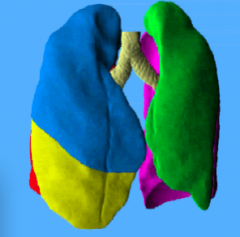
- Left Upper Lobe (w/ lingula) and Left Lower Lobe
- They overlap a lot |
|
|
What are the implications of the lobes overlapping?
|
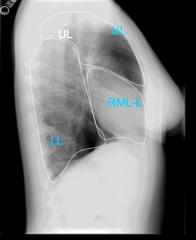
- You may not be able to tell which lobe has the abnormality
- Will need a lateral view to determine whether it is middle or lower lobe |
|
|
What kind of imaging tests are used for cross-sectional imaging of chest?
|
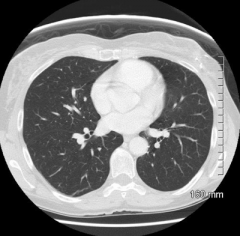
- CT
- MRI (but not used very often in evaluation of pulmonary infections) |
|
|
Why are MRIs not used very often for cross-sectional imaging of the chest?
|
- Cannot image lung parenchyma well
- Motion artifacts |
|
|
How can chest imaging be useful for pulmonary infections?
|
Often the pattern of disease can be described
|
|
|
What is a round pneumonia (round infiltrates) indicative of?
|
Almost always Streptococcus pneumonia causing pulmonary infection
|
|
|
What is chest wall invasion by pulmonary infection indicative of?
|
Classically, Actinomyces (but could be another bacteria)
|
|
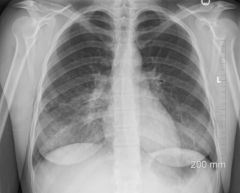
What is the diagnosis of this chest x-ray? What clues?
|
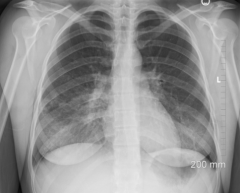
Bronchopneumonia
- Patient w/ cough and low grade fever for four days - Area of increased density in R lower lung base - Slightly asymmetric - Lung apices are nice and dark |
|
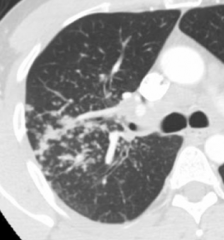
What is the diagnosis of this chest CT? What clues?
|

Bronchopneumonia (usually don't require CT)
- "Tree in bud" opacification - Appearance of trees in spring when they first get their buds |
|
|
What helpful signs should you look for in pneumonia?
|
Silhouette sign:
- R cardiac border: RML infiltrate - R diaphragm border: RLL infiltrate - L cardiac border: Lingual infiltrate Air bronchogram sign: pneumonia |
|

What is the diagnosis of this chest x-ray? What clues?
|
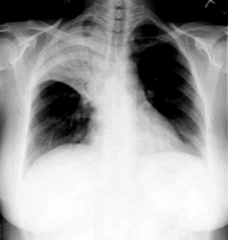
Lobar Pneumonia in RUL
- Minor fissure is elevated - RUL is full of pus and has collapsed - Can't see mediastinum on R side because of a soft tissue-soft tissue interface - Linear lucencies in RUL = air bronchograms (patent air waves) |
|

What is the diagnosis of this chest x-ray? What clues?
|
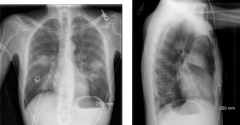
Multifocal Infiltrate Pneumonia
- Have infiltrates in: R perihilar region, RML, and lingua - Lung apices are okay, no pleural effusion (need to look for that w/ pneumonia) |
|
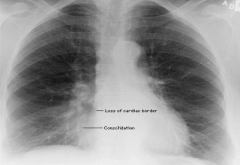
What is the diagnosis of this chest x-ray? What clues?
|

RML infiltrate pneumonia (loss of cardiac border on R side, the RML is adjacent to R heart border)
|
|
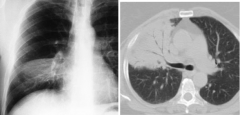
What is the diagnosis of this chest x-ray / CT? What clues?
|
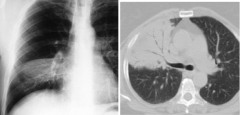
Lobar Consolidation Pneumonia of RML
- Infiltrate goes up to fissure (no communication between lobes) - Silhouettes out R heart border - Confirmed location based on CT |
|
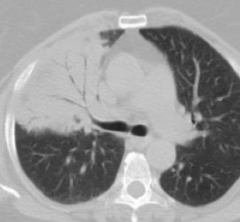
What is the diagnosis of this chest CT? What clues?
|
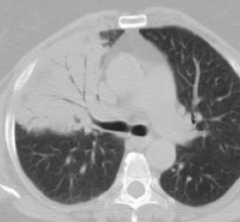
Patent bronchi in an area of collapsed and consolidated lung (RML)
|
|

What is the diagnosis of this chest x-ray? What clues?
|

Miliary TB:
- Innumerable small nodules |
|
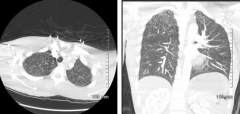
What is the diagnosis of this chest CT? What clues?
|
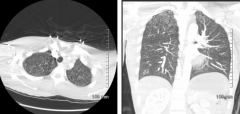
Miliary TB:
- Innumerable small nodules - TB loves the upper lobes especially |
|
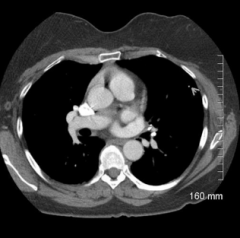
What is the diagnosis of this chest CT? What clues?
|

Histoplasmosis:
- Calcified nodules in lung parenchyma - From indolent infection from being in outdoors (very common) |
|
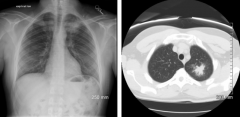
This patient was treated with antibiotics, but still has this notable infiltrate on chest x-ray and CT. What is the diagnosis?
|
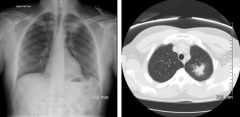
Blastomycosis - nothing specific for it, but because it wasn't relieved by antibiotics, this is more likely
|
|
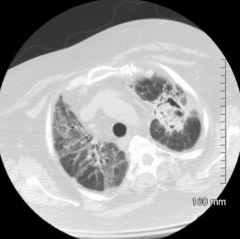
What is the diagnosis of this chest CT? What clues?
|
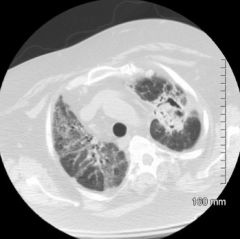
Aspirgillosis infection - mass is an Aspirgilloma
- If you moved the patient around and re-imaged them the Aspirgilloma would move around whereas a tumor would not |
|
|
How do you tell the difference between Aspergilloma and Squamous Cell Carcinoma?
|
- Aspergilloma will move around in lung cavity as patient moves, so different positions for imaging will show movement
- Squamous Cell Carcinoma will stay in one place - Need ultimate diagnosis w/ bronchoscopy |
|
|
What are the four clinical scenarios of getting an Aspergillus infection?
|
- Severely immunosuppressed (invasive Aspergillus)
- Immunosuppressed (semi-invasive Aspergillus) - Normal immunity but w/ abnormal lungs (Aspergilloma) - Hyper-immune (ABPA - allergic bronchopulmonary Asperigillosis |
|
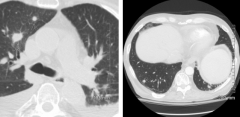
What is the diagnosis of this chest CT? What clues?
|
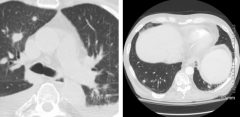
Invasive Aspergillosis
- Nodules throughout entire chest - Ill defined nodular densities - More common in severely immunosuppressed |
|
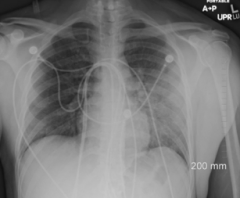
46-yo male w/ AIDS. Presents w/ low grade fever and cough. Hypoxic. Chest radiograph shows minimal patchy densities.
Next test? |
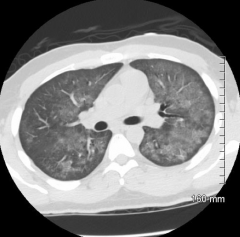
CT - because immunosuppressed need to start treating immediately
|
|
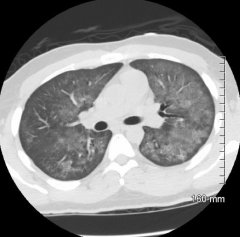
What is the diagnosis of this chest CT? What clues?
|
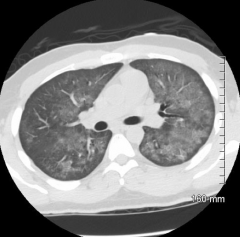
PCP (Pneumocystis Pneumonia)
|
|
|
What are the findings for viral lung disease?
|
Wide spectrum of non-specific findings:
- Normal - Patchy infiltrates - Diffuse, severe infiltrates |
|
|
What is worrisome about a viral lung disease?
|
Risk for superimposed bacterial pneumonia
|
|
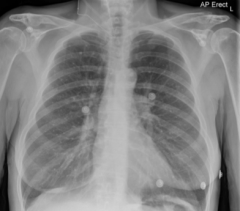
What is the diagnosis of this chest x-ray? What clues?
|
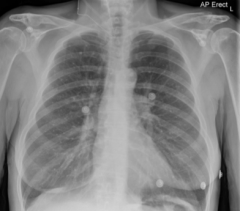
Varicella Pneumonia:
- Calcified nodules are sequelae of varicella pneumonia - Get these nodules after the varicella pneumonia is treated/healed - Looks similar to Histoplasmosis, but in Histo usually there are not as many of these nodules and you also can get hilar node calcifications |
|

What is the diagnosis of this chest x-ray? What clues?
|
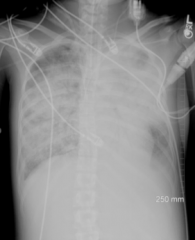
Acute Respiratory Distress Syndrome
- Overwhelming pneumonia that wasn't treated soon enough - Extensive, diffuse infiltrates on both sides - Air bronchograms - Pleural effusion |
|
|
What is the cheapest way to determine if a pleural effusion is loculated or free flowing?
|
Decubitus Radiograph - have patient lay on side to see if the fluid moves
|
|
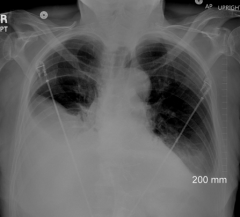
What is the diagnosis of this chest x-ray? What clues?
|
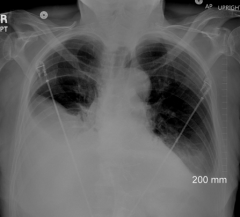
Bilateral Pleural Effusions
|
|
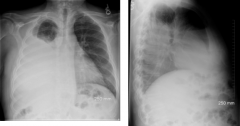
What is the diagnosis of this chest x-ray? What clues?
|
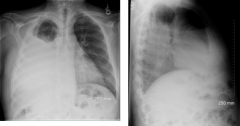
Large R Pleural Effusion
|
|

What is the diagnosis of this chest CT? What clues?
|

R pleural effusion
|

